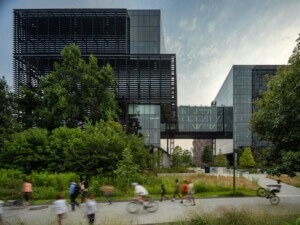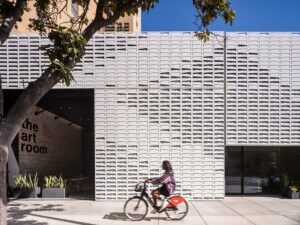An ambitious designer used Rhino to design and fabricate 20 variations on a chair in four months.
For a designer aiming to streamline the gap between design and manufacturing, parametric modeling tools are a natural solution. LA-based Alexander Purcell Rodrigues found a place to work in just such a way at the Neal Feay Company (NF), a 60-year old fabrication studio in Santa Barbara, California, that is known for its exceptional metalworking. Together, the designer and the fabrication studio created the Cartesian Collection of chairs, aptly named for the analytic geometry that helped facilitate close to 20 design variations on the same aluminum frame in just under four months. “Not only were we pushing the boundaries of aluminum fabrication, the aim was to simultaneously create a lean manufacturing process,” said Rodrigues.
Using Rhino with a Grasshopper plugin, Rodrigues developed a design for a chair that weaves together the simplicity of Western design with the complex ornamentation of traditional Eastern aesthetics. While the lines of the chair are clean and smooth, intricate embellishments on the back traverse multiple planes and angles, all on a shrunken scale. The time savings involved in designing with Rhino allowed the creation of another 19 variations on the theme.
- Fabricators Neal Feay Company
- Designers Alexander Purcell Rodrigues
- Location California
- Date of Completion May 2013
- Material aluminum, ombré anodized finish, screws, oak, walnut, upholstery
- Process Rhino, Grasshopper, SolidWorks, Mastercam, CNC milling
Rather than working with large billets of aluminum, Rodrigues and NF’s Alex Rasmussen opted to fabricate the chair from ½-inch stock, with an option for wooden legs or an upholstered seat. “The most difficult thing was the back rest because it required the most unconventional process,” said Rasmussen. “Once it was bent into a the basic form, the back was put into a four-axis machine that works in an X, Y, Z, and rotational axis to apply texture.” An anodized finish, which transitions between two colors for an ombré effect, adds to the bespoke appearance.
Working collaboratively to solve hiccups in the fabrication process was a key component to the success of the project, and experimenting with tool paths helped create new patterns. Manipulating the original design in Grasshopper accounted for even minute deflections in the real-world fabrication scenario. “With this formula, you can play with variables that go in a hundred directions and multiply quickly,” Rodrigues said of the freedom of working in the program. “The world is your oyster in Grasshopper.”
The team worked with aluminum for the frame of the chairs, a material choice that was made in part due to the fact that NF specializes in the material. In addition, the lightweight metal allowed a greater degree of accuracy than injection or press molding. “You can get all the screw caps and holes so exact with a precision of perfection you can’t recreate in other materials,” said Rodrigues. “And experimenting with the ombré anodized finish, NF pushed the boundaries very well, for something so thin and elegant.”










